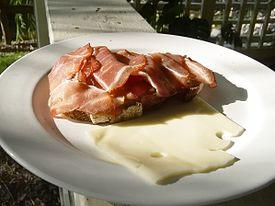Westphalian ham (German: Westfälischer Schinken) is a ham produced from acorn-fed pigs raised in the forests of Westphalia, Germany.[1][2] The resulting meat is dry cured and then smoked over a mixture of beechwood and juniper branches.[1][3][4][2]
The hams are prepared for consumption solely by the process of smoking, which preserves them, and are typically eaten thinly sliced in their preserved state without additional cooking.[3][5][6][7][8]
Westphalian ham is famed as a delicacy.[3][4]
History
During his travels in Germany, Thomas Jefferson documented the production of Westphalian ham and aspects of the hogs used to produce it.[1]
In the early 1900s, there were three varieties of Westphalia ham: kugel cut, boneless and rolled, and regulation ham.[9]
In the early 1900s, significant quantities of Westphalian ham were being exported from Germany into the United States.[3]
In popular culture
In a scene from the 1937 film Easy Living, Edward Arnold's character disdains lobster for breast of Guinea hen served on Westphalian ham.[10]
In Season 5 Episode 20 To Market To Market of the television comedy Murphy Brown, Charles Kimbrough's character Jim Dial waxes nostalgic about his summertime childhood memories of Westphalian ham sandwiches.
See also
- List of hams
- List of smoked foods
- Smoked ham
References
- ^ a b c Hayes, Kevin J. (2008). The Road to Monticello: The Life and Mind of Thomas Jefferson. Oxford University Press. pp. 363. ISBN 0199758484.
- ^ a b The Encyclopedia of Healing Foods - Michael T. Murray, Joseph E. Pizzorno. p. 616.
- ^ a b c d Daily Consular and Trade Reports. Department of Commerce and Labor, Bureau of Manufactures (U.S.). 1912. p. 55.
- ^ a b Swindled: The Dark History of Food Fraud, from Poisoned Candy to Counterfeit ... - Bee Wilson. p. 11.
- ^ Processed Meats. p. 344.
- ^ German Cooking - Marianna Olszewska Heberle. pp. 166-167.
- ^ The Boston Cooking-school Cook Book - Fannie Merritt Farmer. p. 238.
- ^ Handbook of Poultry Science and Technology, Secondary Processing. p. 218.
- ^ Rivers, Frank (1916). The Hotel Butcher, Garde Manager and Carver. Hotel Monthly Press. pp. 45–46.
- ^ refer to transcript
